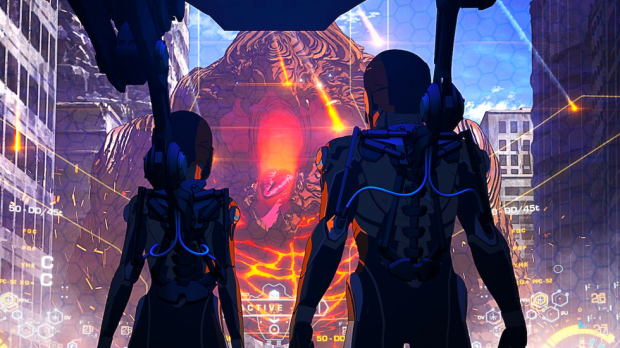
Developed and co-written by Greg Johnson and Craig Kyle
Starring Calum Worthy, Gideon Adlon, Erica Lindbeck
Network: Netflix
This Netflix Original is a Japanese-American adult animated series that uses 3D-based anime styles. It’s an animation not for everyone, but once the viewer moves past this, an interesting story based on the fan-favourite franchise awaits.
Set far into the future, after the events of Pacific Rim: Uprising, another breach cuts through the continent of Australia. Kaiju return in droves, and soon the country is overrun. A mass evacuation is issued, with multiple Jaegers attacking the Kaiju menace as it lays waste to the lower hemisphere. This is where we meet the Travis family, as they risk their lives to get a school bus of civilians out of harm’s way. Hayley and Taylor’s parents leave for Sydney, the last of the Pacific Rim Defence Force bases, but never return.
It is unclear what “The Black” means – initially the government attack on Australia and the release of bombs to stop the Kaiju surge was believed to be the foundation. But then characters mention the breach itself as “The Black,” making the return event the namesake. But seven years later, Hayley discovers a training Jaeger: Atlas Destroyer, underneath their Outback Oasis. After an error in judgement, the activation of the Jaeger draws the attention of a Kaiju, and the survivors (bar the Travis’) are killed. As they leave the safety of the Outback, Taylor and Hayley must contend with marauding Kaiju, morally ambiguous survivors, and unravelling the new plot from the Precursors.
Atlas Destroyer is an interesting adage to the Pacific Rim franchise, with Loa – the Jaeger’s artificial intelligence, providing the majority of the humour in the series, with sarcastic and naïve quips to the characters it interacts with. A couple episodes in, we meet The Boy, an experiment found in the dilapidated HQ of the Defence Force. He is devoid of understanding yet being roughly seven years old. He eats insects, and kills reptiles, like a cat showing off their prey. It’s unclear what his purpose is in the series, until the latter two episodes, where his connection with the Kaiju is explained.
At the same time, the reveal of bio-mechs is brought up – having been touched on in Pacific Rim: Uprising. But in this instance, the Kaiju DNA has fused with a full Jaeger, that terrorises a random city, eating Kaiju hounds. Amidst the myriad of franchise development is the introduction of Ghost Piloting. We have seen this before, in the first Pacific Rim when Raleigh pilots the Jaeger to the beach, after the death of his brother. Taylor Ghost Drifts with Herc Hanson’s data memory but receives malignant memories later on. This interesting piece of canon is all but irrelevant for the overall series but is a nice easter egg for fans of the main franchise.
Pacific Rim: The Black opens up new concepts for the franchise and gives the fandom something else to work with, although, the series feels like an extended movie – and at times, an interactive video game. The Australian accents provided by American and Canadian actors are always a hard sell, suggesting the international market has only ever watched Crocodile Dundee. Additionally, the final moments of Episode Seven introduce a religious-cult element to the series, which feels like shoehorning a third aspect that deviates from the canon.
Overall, Pacific Rim: The Black is a short and worthwhile watch for anyone interested in the original fandom. It bridges the gap between anime and Japanese monster-movie fans, doing enough to be been greenlit for a second season.
JOSHUA HALL HAINES